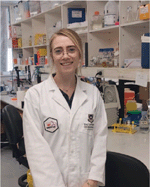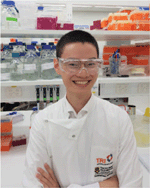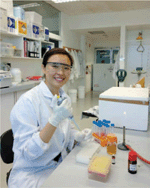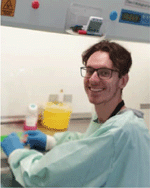ASM Summer Student Research Awards: 2020
Microbiology Australia 41(3) 159-162 https://doi.org/10.1071/MA20041
Published: 19 August 2020

|
Priscilla Johanesen
Chair, ASM Standing Committee for Professional Development
Every year, ASM awards a number of research stipends to undergraduate or masters by coursework students so that they can perform a project in a research laboratory focusing on Microbiology. The purpose of this award is to foster the involvement of students in research so that they can understand how research is planned and performed. Since 2018, the Society has provided 24 such awards, which means that 24 students have had the opportunity to engage in research in a way that they may not have been able to otherwise.
This year the society awarded nine ASM Summer Student Research Awards. It was great to see the diverse projects in Microbiology performed by students over the summer vacation period. This year the successful awardees were: Georgina Joyce and Joeyan Wang from Queensland; Kiera Lowe from South Australia; Li Teng Chong from Tasmania; Adeline Chew, Irena Jovanovska and Jay Laws from Victoria; and Justine Bendo and Coel Garrod from Western Australia. The society would like to congratulate all of the winners of the 2020 Summer Student Research Awards and wish them all the best for the future.
Queensland
Georgina Joyce

|
ISEc53 presence in Escherichia coli ST131 fimB and its effect on fimS switching
Georgina H Joyce, Minh-Duy Phan and Mark A Schembri
School of Chemistry and Molecular Biosciences, University of Queensland
Escherichia coli sequence type (ST) 131 is a uropathogenic and multidrug resistance clone responsible for many cases of urinary tract infections globally. Type 1 fimbriae are cell-surface expressed organelles encoded by the fim operon involved in virulence. Within the operon, fimB encodes a recombinase that mediates the ‘off’ to ‘on’ switching of an invertible promoter sequence, fimS. An insertion sequence, ISEc53 is located within the fimB gene (fimB::ISEc53) of many ST131 strains, thereby altering the regulation of fim expression. This project investigated the prevalence of fimB::ISEc53 amongst E. coli STs. It was confirmed that fimB::ISEc53 is highly specific to ST131, whilst ISEc53 is found widely. We also employed amplicon sequencing as a quantitative technique for assessing fim switching, which showed no significant difference in type 1 fimbriae expression between two uropathogenic stains, EC958 and CFT073, under static, aerated conditions despite the presence of fimB::ISEc53 in EC958.
Joeyan Wang

|
Determining the presence of inhibitory antibodies in P. aeruginosa bacteremia
Joeyan WangA, Johannes HoehensteigerA, Kate McCarthyB and Timothy WellsA
AThe University of Queensland Diamantina Institute
BThe University of Queensland Centre for Clinical Research
Pseudomonas aeruginosa is an opportunistic pathogen that is a major cause of acute infections in hospitals and often leads to bacteraemia. P. aeruginosa blood stream infections (BSI) are particularly problematic to treat due to high antibiotic resistance. Serum-resistance is key for survival in the bloodstream. Recently we found a specific type of antibody that protects bacteria from serum-mediated killing. This ‘inhibitory antibody’ is IgG2 specific for bacterial O-antigen and has been found in E. coli urosepsis and P. aeruginosa lung infections. Its role in P. aeruginosa BSIs is unknown. We determined if inhibitory antibodies exist in a cohort of 16 patients with P. aeruginosa BSI. Each patient isolate was serotyped before isolation of LPS. The presence of IgG2 specific to O-antigen was examined for each patient sera against their cognate isolates’ LPS, of which only two of the sixteen patients (BPI 3, BPI 23) had high titres of antibody. Serum bactericidal assays revealed the sera of BPI 3 were unable to inhibit serum mediated killing but BPI 23 sera did inhibit serum mediated killing. Thus, one out of sixteen patients had sera that could inhibit mediated killing of P. aeruginosa, likely due to the presence of inhibitory antibody.
South Australia
Kiera Lowe

|
Developing plasma-activated liquids for the treatment of antibiotic resistant bacteria and biofilms
Kiera Lowe and Katharina Richter
Basil Hetzel Institute for Translational Health Research, University of Adelaide
Antibiotic resistant bacteria pose a major risk for public health worldwide. With superbugs continuously emerging and spreading, even minor injuries and common infections are becoming more difficult to treat, hence, new therapies are urgently needed. Plasma activated water (PAW) has been proposed as a novel treatment against antibiotic-resistant bacteria in planktonic form and biofilms. Plasma activation is a physical process to enhance the surface properties and reactivity of materials. Planktonic and biofilm assays as well as confocal microscopy were used to determine the impact of PAW against free-floating bacteria and pre-established biofilms, in which PAW was found to successfully kill or prevent growth of multiple strains of bacteria. This report showed that PAW has high efficacy against antibiotic-resistant bacteria and biofilms of both Gram-positive and Gram-negative microorganisms, potentially offering a new avenue to tackle superbug infections.
Tasmania
Li Teng Chong

|
Development of real-time PCR for the identification and quantification Clostridium algidicarnis and C. putrefaciens on vacuum-packed (VP) lamb meat
Li Teng Chong, Laura Rood, Chawalit Kocharunchitt and John P Bowman
Centre for Food Safety and Innovation of the Tasmanian Institute of Agriculture, University of Tasmania
Clostridium spp. can cause spoilage in VP lamb meat samples under chilled conditions (–1.5°C). Monitoring the growth of clostridia on VP lamb meat would be useful in inventing treatments to extend shelf-life. Direct cultivation of clostridia is challenging and time consuming. Thus, a molecular approach such as real-time PCR (qPCR) is required. This study aims to develop qPCR for the direct identification and quantification of C. algidicarnis and C. putrefaciens. Primers designed for C. algidicarnis/putrefaciens (C.put-alg) were tested for their specificity against C. algidicarnis and other meat isolates. Triplicates of six 10-fold serial dilutions of DNA from C. algidicarnis were used to establish a standard curve for qPCR. The primer set produced amplicons from C. algidicarnis and Serratia spp. The melt curve analysis showed that a single amplicon was produced in qPCR. The standard curve had a high linearity (R2) of 0.99966 and a moderate efficiency of 0.70093. The specificity of C.put-alg primer set against C. putrefaciens and Serratia spp. in qPCR needs to be investigated. Once resolved, the absolute quantification of C. putrefaciens and C. algidicarnis is possible based on this standard curve. In the future, this qPCR can be used to assess the efficacy of antimicrobial interventions.
Victoria
Adeline Chew

|
Trypan blue is a more effective stain for determining viability of Batrachochytrium dendrobatidis zoospores than methylene blue
Adeline Chew, Laura Brannelly, Lee Berger and Matt West
The University of Melbourne
The fungus Batrachochytrium dendrobatidis (Bd) is a major threat to global amphibian populations. Improving our knowledge of the fungus often requires assessing its viability under different conditions. While several protocols of estimating viability are available, there has not been a direct comparison. I compared two viability stains, trypan blue and methylene blue, and found that trypan blue is a more reliable and consistent stain for determining viability of Bd zoospores. This study supports the use of trypan blue and encourages further investigation into refining other methods of assessing Bd viability.
Irena Jovanovska

|
Isolation of bacteria from a splash park in Melbourne and determination of their biofilm formation capabilities and antibiotic-susceptibility
Irena Jovanovska, Sarah McLean, Lauren Cullinan and Enzo Palombo
Department of Chemistry and Biotechnology, Swinburne University of Technology
Despite the increased popularity of splash parks, microbiological regulations in Victoria were not implemented until 2019. These guidelines currently recommend performing a microbiological analysis every three months. This research aimed to assess the adequacy of these guidelines by performing microbiological testing of water and surfaces in local splash park. In total, 42 bacteria were isolated, including one gram-positive coccus, 24 gram-positive rods, and 14 gram-negative rods, with the majority of gram-positive bacteria isolated from the water samples, and predominantly gram-negative bacteria from the surface swab sample, all confirmed as catalase positive. Seventeen of the isolates were identified as belonging to the genera Bacillus, Pseudomonas, and Staphylococcus using MALDI-TOF MS, some of which are known as opportunistic pathogens. Antibiotic susceptibility testing indicated the presence of multi drug resistant strains. Numerous strong biofilm-formers were observed, the majority of which were isolated from the swab sample.
Jay Laws

|
Localization of antiviral signalling proteins to lipid droplet fractions
Jay Laws, Ebony Monson and Karla Helbig
Department of Anatomy, Physiology and Microbiology, La Trobe University
Lipid droplets (LDs) have recently been shown to play an important role in the antiviral host response. Proteomic analysis has revealed that pivotal host proteins may localise to the LD during this response, however, a technique to visualise these proteins in the live LD fraction has not been developed. In this study, primary immortalised astrocyte cells were transfected with fluorescently tagged protein targets and LD isolations were performed to visualise these proteins in the live LD fractions. We demonstrated that an antiviral protein, viperin and not the cytoplasmic fluorescent protein mCherry localised to the fractions, as seen via fluorescence microscopy. Once visualised, expression of the antiviral protein was confirmed via western blot analysis. This study presents a method for the visualisation of proteins of interest in live LD fractions to better understand their localisation and function within a cell.
Western Australia
Justine Bendo

|
Characterisation of putative class D and class A β-lactamases found in Burkholderia cenocepacia
Justine Bendo, Aleksandra Debowski, Keith Stubbs and Mitali Sarkar-Tyson
The University of Western Australia
Burkholderia cenocepacia is one of the major pathogens that affects people suffering from cystic fibrosis (CF) and is also one of the most common bacterial isolates from the Burkholderia cepacia complex (Bcc) in Australia. Current treatment options for individuals with B. cenocepacia infection are the use of β-lactam antibiotics; however, resistance is observed due to the bacteria’s ability to produce β-lactamases that act to hydrolyse the antibiotic, rendering it ineffective. Four β-lactamases were identified in B. cenocepacia strain J2315 after its genome was sequenced, including two putative β-lactamase genes, BCAM0393 and BCAM1779. The aim of this study was to characterise these putative β-lactamase genes using E. coli BL21 (DE3) as a model. E. coli strains expressing one of the four β-lactamase genes: penB, ampC, BCAM0393 and BCAM1779 were tested using MIC determination to identify the ability of each gene to confer resistance to β‐lactams. All of the β-lactamases conferred varying degrees of resistance to the antibiotics tested. Overall, this project has demonstrated that B. cenocepacia has four β-lactamases that act to deactivate a wide range of β-lactams. This result highlights that new compounds and modes of action need to be found and developed to combat infections caused by this bacterium.
Coel Garrod

|
Promiscuous and non-permissive amino acid changes during coevolution of new DNA binding specificities for antimicrobial-resistance gene transfer
Coel Garrod, Karina Yui Eto and Joshua P Ramsay
Curtin Health and Innovation Research Institute and School of Pharmacy and Biomedical Sciences, Curtin University
DNA-binding proteins are ubiquitous in nature but it is often unclear how site-specific DNA-binding proteins evolve new specificities. In Staphylococcus aureus, the pWBG749 family of conjugative antimicrobial-resistance plasmids encode DNA-binding proteins named SmpO. SmpO proteins recognise the cognate origin-of-transfer (oriT) sequence on each conjugative plasmid and appear to have switched their DNA target specificity frequently during evolution. Previous work demonstrated a single amino-acid change (F7K) SmpO protein enables recognition of a new oriT – OT45 – in addition to the original cognate oriT, OT49. However, naturally occurring proteins do not bind both oriT, suggesting additional mutations have evolved to prevent binding both oriT. In this work we constructed seven additional amino-acid changes in SmpOF7K to identify such changes. The double-mutants were cloned into pLI50 and used in conjugative mobilisation experiments to evaluate if the secondary mutations reduced mobilisation. All of the mutants reduced the mobilisation rate, with the L16I and D14E mutations showing the greatest reductions; however, none of the mutations completely abolished mobilisation of the OT45 oriT. These observations support an evolutionary model whereby SmpO proteins first gain changes allowing promiscuous binding to multiple oriT and subsequent mutations cumulatively reduce binding to the previous site. Importantly, this suggests recognition of new target sequences for conjugative mobilisation may evolve rapidly and enable further antimicrobial-resistance gene dissemination through mobilisation.


